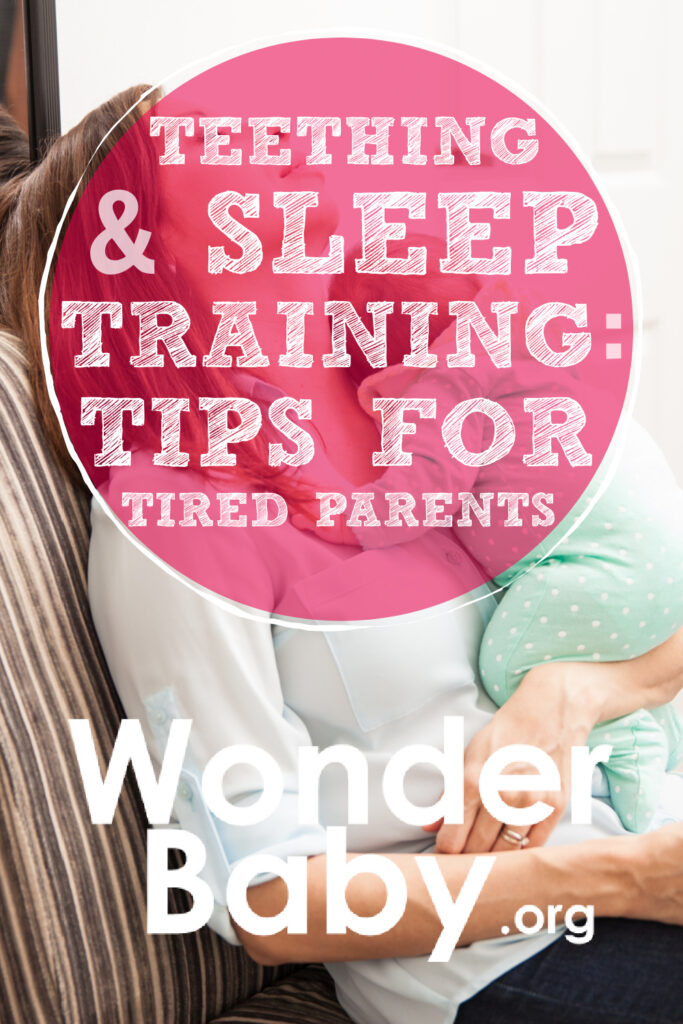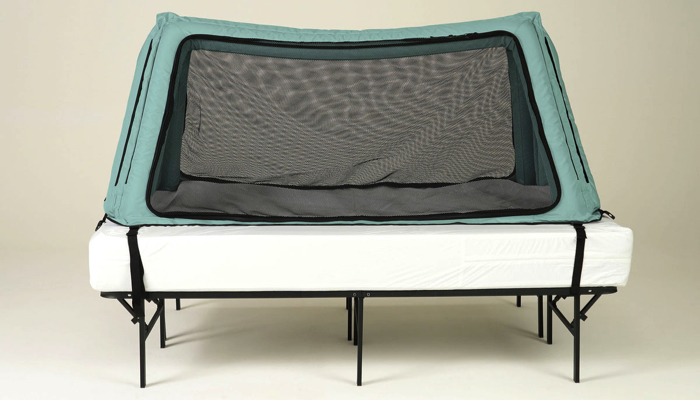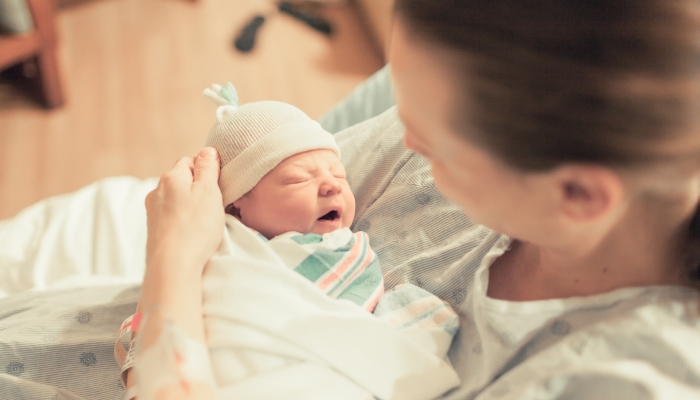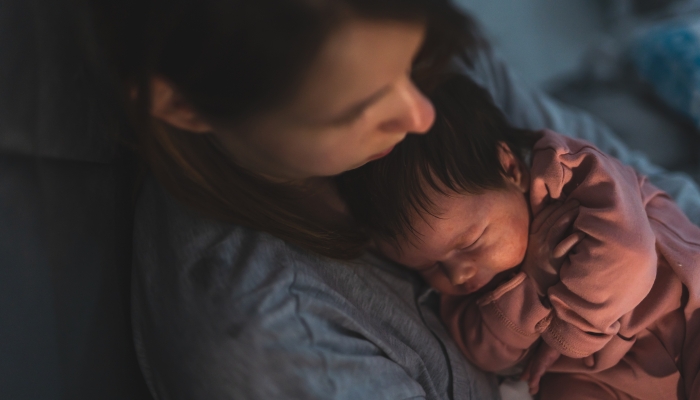Teething and Sleep Training: 5 Tips for Tired Parents

- Teething symptoms include swollen gums, drooling, low-grade fevers, and sleep disturbances.
- It’s important to establish which teething symptom is causing the sleep disruption.
- You can stick to your current sleep training routine during teething, but be sure to provide extra comfort to alleviate your little one’s pain.
I was lucky enough to never know when my babies were teething. They’d just wake up with a new tooth! But I know many parents can’t say the same, and when they’re sleep training, teething can cause a lot of disturbances.
Sounds familiar? You’re not alone!
In 2011 researchers examined 47 teething infants between the ages of 5 and 15 months with the help of dentists. Their study found that teething is associated with various symptoms11. Ramos-Jorge, J., Pordeus, I. A., Ramos-Jorge, M. L., & Paiva, S. M.. Prospective Longitudinal Study of Signs and Symptoms Associated With Primary Tooth Eruption. Pediatrics. 2011;128(3), 471–476. https://doi.org/10.1542/peds.2010-2697, including sleep disturbances.
If you’re navigating this rollercoaster ride of teething and sleep training your little one, some helpful tips will help you along the way.
So, grab a cup of coffee, take a deep breath, and let’s conquer teething pains and sleepless nights together!
Parents’ Guide to Handling Sleep Training and Teething: 5 Tips

Teething pains can disrupt all the sleep training progress you’ve made. Here are some tips for managing this challenging time and getting your baby’s sleep schedule back on track:
Establish Which Teething Symptom Is the Problem
Several symptoms can be a sign of teething. Your baby could experience all or none! If you notice your baby’s gums are swollen, they’re excessively drooling, or they have a low-grade fever, it could be teething.
It’s important to establish which teething symptom makes your baby lose sleep.
- Sore Gums: Gum swelling and sensitivity could cause discomfort when lying down. Your baby might need to sleep in a different position than usual.
- Drooling: Increased drooling can lead to wetness around the mouth, chin, and neck. Your little one’s skin might be irritated in this area, making it harder for them to settle and sleep. You could use an ointment to ease the discomfort.
- Fever: Babies tend to get a low-grade fever while cutting teeth. This mild increase in body temperature can make them feel uncomfortable and restless, affecting their normal sleep routine.
Once you know which teething symptom is disrupting your child’s sleep, you have a better chance of solving it—quickly!
Target the Pain First
If you’re certain your baby is teething and can’t figure out which symptom is causing discomfort, target the pain.
Don’t put your little one in their crib and wait for them to become fussy. Get them as comfortable as possible by focusing on pain relief before bedtime. It’s easier to sleep train when your baby is calm and content.
You can use several remedies to ease your baby’s pain, including pediatrician-approved medicine and recommended home remedies, like giving your little one cold teething rings to chew on.
Stick to Your Current Routine, but Make Room for Extra Comfort
Routine is crucial when sleep training. Most children find comfort in familiarity. If they know what’s happening next, they’ll be less resistant to it.
When your little one is teething, letting go of your routines can be tempting. You’re probably tired, overwhelmed, and just trying to keep your baby calm and comfortable.
But you need to stick to the bedtime routine you’ve been using until now. If your baby knows that bathing comes before bedtime, keep doing this. If you’ve been rocking them to sleep or using white noise, don’t stray from these habits.
Consistency will help your baby settle despite their teething pains, even if it doesn’t feel so at first.
Note: If your baby is in pain, provide extra comfort, even if this isn’t part of your sleep training approach. Holding them when they’re crying or being fussy won’t ruin your progress. Kids need comfort to get through rough patches like teething.
If you need to, learn about gentler sleep training methods.
Monitor Discomfort and Pain

You should monitor your baby’s pain and discomfort levels and adjust your sleep training approach accordingly.
If you’re following a method that requires you to only attend to your baby when they get fussy, toss this out the door while they’re teething.
You need to check in on your little one throughout the night, even when they seem content.
Mild symptoms are normal during night teething, but be on alert for additional concerning signs. These include:
- High fever (100.4°F or 38°C)
- Diarrhea
- Vomiting
- Signs of an ear infection
If you notice any of this during the night (or day), you need to consult your pediatrician to rule out other possible causes.
Take Care of Yourself
You can’t pour from an empty cup. It’s important to prioritize self-care, even if it looks different than usual.
It isn’t easy staying cool and collected when your little one is extremely fussy or frequently wakes at night. But you need to. Not just for your own sanity but for your baby as well.
When you’re agitated and overwhelmed, they’ll feel it. And it could make them even fussier, which in turn has a worse impact on your sleep training progress.
Here are some ways to energize yourself so you can be there when your teething baby needs you the most:
- Ask your partner, family, or friends for help. We all need a village.
- Rest and sleep whenever possible. Take turns with your partner or ask a family member to take over for an hour or two.
- If your child is calm, take a few minutes to drink tea, scroll through your phone, or feel the sun on your skin.
- Try to eat nutritious meals and stay hydrated. This will boost your energy levels and enhance your mood.
- Find healthy ways to manage stressful moments, like breathing deeply.
- Communicate your needs and ask for advice.
- Be kind to yourself, and know that this difficult phase will pass.
Taking care of yourself will help you be more present and responsive to your baby’s needs.
Those few minutes alone could also give you a different perspective or help generate a new idea for tackling your baby’s teething issues.
Facts About Teething and Sleep Training

Here are some important things to keep in mind about teething babies and sleep training:
Fact 1: Teething doesn’t always disrupt sleep training. Your little one might even find the familiarity of their sleep training routine soothing.
Fact 2: There are several gentle sleep training methods that make getting through the teething stage easier. These include the fading approach, the chair method, and the pick-up-put-down method.
Fact 3: Sleep training doesn’t have a one-size-fits-all approach, and you could be having trouble even when your baby isn’t teething. Don’t feel discouraged if it takes longer to see results than expected.
What to Avoid When Sleep Training a Teething Baby
Sleep training can be stressful, and you might grab at anything that could help you get through the teething phase. But if you don’t want to mess up your sleep training progress, you should never do these things:
- Introduce comfort objects or difficult-to-break habits.
- Break your routine completely to accommodate the discomfort of teething.
- Rush the sleep training process.
- Overmedicate in hopes that it would calm your baby and make sleep training easier.
Your baby needs extra comfort and soothing when they’re teething. Always try to address the pain and avoid making drastic changes. But remember to give enough cuddles and ensure your little one knows you’re there to help them get through it.
FAQ’s
How can I distinguish between teething pain and other possible causes of sleep disturbances in babies?
Other issues often get mistaken for teething difficulties. Babies can exhibit similar symptoms for different reasons. You should always look for multiple teething signs to ensure this is what your child is going through.
If sleep disturbances are paired with swollen gums, diarrhea, a loss of appetite, and excessive drooling, it could be teething.
It’s also a good idea to look at typical teething schedules. Most babies start teething around 4–7 months.
How long does teething affect sleep?
Sleep disturbances associated with teething are temporary. They typically resolve once the tooth has erupted. This can vary from a few days to a few weeks and usually depends on the specific tooth coming through.
Be patient, and ask for help if you need any.
Reference
- Ramos-Jorge, J., Pordeus, I. A., Ramos-Jorge, M. L., & Paiva, S. M. (2011). Prospective Longitudinal Study of Signs and Symptoms Associated With Primary Tooth Eruption. Pediatrics, 128(3), 471–476. https://doi.org/10.1542/peds.2010-2697

Related Posts

Sleep, Special Needs
Safe Place Bedding Travel Bed Review
Traveling with a special needs child can be stressful! Having a safe, durable, and easy to use travel bed can make traveling so much easier!

Sleep, Special Needs
Sleep Regimen for Premature Babies: Special Considerations
It can take premature babies much longer than their full-term peers to sleep for long stretches. A preemie sleep schedule may encourage better sleep.

Sleep
Mastering the Bedtime Routine: 3 Tips for a Peaceful Night’s Sleep
From around six weeks, a newborn bedtime routine can help your baby learn the difference between day and night and prepare for a restful night’s sleep.